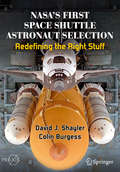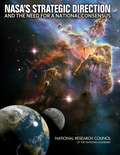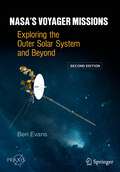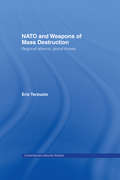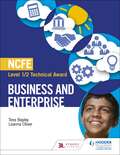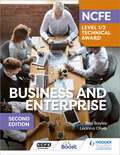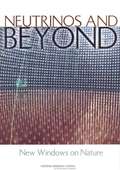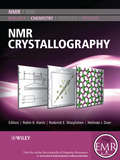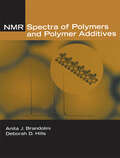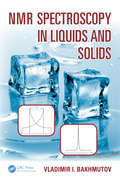- Table View
- List View
NASA's First Space Shuttle Astronaut Selection: Redefining the Right Stuff (Springer Praxis Books)
by Colin Burgess David J. ShaylerUnofficially they called themselves the TFNG, or the Thirty-Five New Guys. Officially, they were NASA’s Group 8 astronauts, selected in January 1978 to train for orbital missions aboard the Space Shuttle. Prior to this time only pilots or scientists trained as pilots had been assigned to fly on America’s spacecraft, but with the advent of the innovative winged spacecraft the door was finally opened to non-pilots, including women and minorities. In all, 15 of those selected were categorised as Pilot Astronauts, while the other 20 would train under the new designation of Mission Specialist. Altogether, the Group 8 astronauts would be launched on a total of 103 space missions; some flying only once, while others flew into orbit as many as five times. Sadly, four of their number would perish in the Challenger tragedy in January 1986. In their latest collaborative effort, the authors bring to life the amazing story behind the selection of the first group of Space Shuttle astronauts, examining their varied backgrounds and many accomplishments in a fresh and accessible way through deep research and revealing interviews. Throughout its remarkable 30-year history as the workhorse of NASA’s human spaceflight exploration, twice halted through tragedy, the Shuttle fleet performed with magnificence. So too did these 35 men and women, swept up in the dynamic thrust and ongoing development of America’s Space Shuttle program. "This book on the Group 8 Astronauts, the TFNGs, is an excellent summation of the individuals first selected for the new Space Shuttle Program. It provides insight into what it took to first get the Space Shuttle flying. For any space enthusiast it is a must read." - Robert L. Crippen PLT on STS-1 &
NASA's Strategic Direction and the Need for a National Consensus
by National Research Council Division on Engineering and Physical Sciences Committee on NASA's Strategic DirectionThe National Aeronautics and Space Administration (NASA) is widely admired for astonishing accomplishments since its formation in 1958. Looking ahead over a comparable period of time, what can the nation and the world expect of NASA? What will be the agency's goals and objectives, and what will be the strategy for achieving them? More fundamentally, how will the goals, objectives, and strategy be established and by whom? How will they be modified to reflect changes in science, technology, national priorities, and available resources? In late 2011, the United States Congress directed the NASA Office of Inspector General to commission a "comprehensive independent assessment of NASA's strategic direction and agency management." Subsequently, NASA requested that the National Research Council (NRC) conduct this independent assessment. In the spring of 2012, the NRC Committee on NASA's Strategic Direction was formed and began work on its task. The committee determined that, only with a national consensus on the agency's future strategic direction--along the lines described in the full NRC report--can NASA continue to deliver the wonder, the knowledge, the national security and economic benefits, and the technology that have been typified by its earlier history. NASA's Strategic Direction and the Need for a National Consensus summarizes the findings and recommendations of the committee.
NASA's Voyager Missions: Exploring the Outer Solar System and Beyond (Springer Praxis Books)
by Ben Evans2022 marks the 45th anniversary of the Voyager probe launches. Launched into space in 1977, these twin probes explored the farthest reaches of the Solar System before venturing on a one-way journey beyond, all the while testing the bounds of science, robotic exploration and our collective imagination. This heavily revised commemorative book takes a comprehensive look at their incredible achievements, future potential and overall legacy.Chronicled herein is an epic journey to unveil the mysterious outer reaches of the Solar System for the first time. The book recounts the Voyagers’ travels through the asteroid belt and past the giant gaseous planets Jupiter and Saturn, as well as Voyager 2’s forays near the distant ice giants Uranus and Neptune. Each chapter details in full the game-changing scientific data and glorious imagery they sent back to Earth.This new edition incorporates all the new data we have learned in the nearly 20 years since its original publication, discussing how the knowledge first gleaned with Voyager has been built upon in subsequent decades by Cassini, Juno and New Horizons.The Voyager probes captured imaginations around the world; now is an opportune time to reflect on their unparalleled quest across the edges of the Solar System and the enigmatic interstellar medium beyond.
NATO and Weapons of Mass Destruction: Regional Alliance, Global Threats (Contemporary Security Studies)
by Eric TerzuoloNATO was hugely successful in facing off the Soviet Union during the Cold War. But has it been equally successful in addressing the "new threats" of the post-Cold War era? This new study assesses the organization's political and military initiatives, and how its outreach to Russia, Ukraine, and other countries in the Euro-Atlantic and Mediterranean regions, devoted considerable attention to WMD proliferation risks. It also probes the political factors, both inside and outside NATO, as well as resource constraints, which have limited the alliance's "added value" in the international community's effort to combat proliferation. The events of 11 September 2001 and bitter intra-alliance controversy over the 2003 Iraq intervention have highlighted questions regarding NATO's future role, and even its continued viability. This is a serious reflection on how the alliance should figure in the fight against WMD and terrorist threats and an examination of today's key issues, including the use of force in international relations and the possibility of constructing new, post-Cold War collective security rules. This is the first study to evaluate, critically and in-depth, how a long-standing security organization has adapted - and must continue to adapt - to the global security challenges of our time. This book will be of great interest to all students and scholars of international politics, military history and all readers interested in the future of NATO and international security.
NCFE Level 1/2 Technical Award in Business and Enterprise
by Tess Bayley Leanna OliverBuild your knowledge and develop the practical enterprise skills you need to achieve the Level 1/2 Technical Award with this brand new textbook, endorsed by NCFE and written by business and enterprise experts Tess Bayley and Leanna Oliver.- Access the information you need using the clear and attractive layout. - Test your knowledge and understanding, with activities and Test Yourself questions throughout.- Reinforce the knowledge and skills you need for both the written exam and synoptic project.- Endorsed by NCFE for the 2018 specification, which is approved for inclusion in the 2020, 2021 and 2022 Key Stage 4 performance tables.
NCFE Level 1/2 Technical Award in Business and Enterprise
by Tess Bayley Leanna OliverBuild your knowledge and develop the practical enterprise skills you need to achieve the Level 1/2 Technical Award with this brand new textbook, endorsed by NCFE and written by business and enterprise experts Tess Bayley and Leanna Oliver.- Access the information you need using the clear and attractive layout. - Test your knowledge and understanding, with activities and Test Yourself questions throughout.- Reinforce the knowledge and skills you need for both the written exam and synoptic project.- Endorsed by NCFE for the 2018 specification, which is approved for inclusion in the 2020, 2021 and 2022 Key Stage 4 performance tables.
NCFE Level 1/2 Technical Award in Business and Enterprise Second Edition
by Tess Bayley Leanna OliverThis Student Textbook is:- Comprehensive - gain in-depth knowledge of each content area with clear explanations of every concept and topic and easy-to-follow chapters.- Accessible, reliable and trusted - structured to match the specification and provide you with the information you need to build knowledge, understanding and skills.- Designed to support you - boost your confidence when tackling the internal non-examined and external examined assessments with plenty of activities to test and consolidate knowledge.- Your go-to guide - expert authors have carefully designed tasks and activities to build your skillset in order to aid progression and questions to assess understanding.
NCFE Level 1/2 Technical Award in Business and Enterprise Second Edition
by Tess Bayley Leanna OliverThis Student Textbook is:- Comprehensive - gain in-depth knowledge of each content area with clear explanations of every concept and topic and easy-to-follow chapters.- Accessible, reliable and trusted - structured to match the specification and provide you with the information you need to build knowledge, understanding and skills.- Designed to support you - boost your confidence when tackling the internal non-examined and external examined assessments with plenty of activities to test and consolidate knowledge.- Your go-to guide - expert authors have carefully designed tasks and activities to build your skillset in order to aid progression and questions to assess understanding.
NEED
by Joelle Charbonneau"No one gets something for nothing. We all should know better." Teenagers at Wisconsin's Nottawa High School are drawn deeper into a social networking site that promises to grant their every need . . . regardless of the consequences. Soon the site turns sinister, with simple pranks escalating to malicious crimes. The body count rises. In this chilling YA thriller, the author of the best-selling Testing trilogy examines not only the dark side of social media, but the dark side of human nature.
NEPA in the Courts: A Legal Analysis of the National Environmental Policy Act (RFF Policy and Governance Set)
by Frederick R. AndersonThis book examines the courts' interpretation of NEPA in its first three years, defeats and successes of citizens' actions in key cases, and implication of court rulings for the act's future effectiveness. Originally published in 1973
NEUTRINOS AND BEYOND: New Windows on Nature
by Neutrino Facilities Assessment CommitteeThe National Academies Press (NAP)--publisher for the National Academies--publishes more than 200 books a year offering the most authoritative views, definitive information, and groundbreaking recommendations on a wide range of topics in science, engineering, and health. Our books are unique in that they are authored by the nation's leading experts in every scientific field.
NF-kappa B
by Michael J. MayFocusing on essential insight into the methods and techniques required to dissect the complex mechanisms of NF-κB activation, regulation, and function. NF-kappa B: Methods and Protocols guides readers through standard approaches to detect NF-κB pathway activation, detection and analysis of NF-κB signaling, and methods to study the control of NF-κB signaling. As a volume in the highly successful Methods in Molecular Biology series, chapters contain introductions to their respective topics, lists of the necessary materials and reagents, step-by-step, readily reproducible protocols, and tips on troubleshooting and avoiding known pitfalls. Comprehensive and authoritative, NF-Kappa B: Methods and Protocols provides a timely and invaluable resource for researchers seeking to perform experiments aimed at understanding the role of NF-κB signaling in health and disease.
NF-κB Transcription Factors: Methods and Protocols (Methods in Molecular Biology #2366)
by Guido Franzoso Francesca ZazzeroniThis detailed book serves as a systematic examination of the analytical methods to study the transcription factor NF-κB in physiology and disease. It provides an up-to-date guidebook to navigate both conventional and highly specialized methods to detect and analyze the different signaling pathways of NF-κB activation and contextualize them within organismal physiology and disease pathogenesis, using genetic and biochemical techniques and some of the most advanced computational and systems biology methods. Additionally, the volume includes several examples of approaches utilized by leading experts in the NF-κB field to analyze and modulate NF-κB signaling in specific physiological and disease contexts, along with some of the most promising approaches to pharmacologically target the NF-κB pathway in human disease. Written for the highly successful Methods in Molecular Biology series, chapters include introductions to their respective topics, lists of the necessary materials and reagents, step-by-step, readily reproducible laboratory protocols, and tips on troubleshooting and avoiding known pitfalls. Authoritative and practical, NF-κB Transcription Factors: Methods and Protocols is an up-to-date guide intended for both basic and translational scientists who are working in the dynamic NF-κB field.
NF-κB-Related Genetic Diseases
by Gilles Courtois Alessandra Pescatore Jérémie Gautheron Francesca Fusco Matilde Valeria Ursini Anna SenegasThis book presents the diverse clinical, cellular and molecular manifestations of NF-KB-related genetic diseases. It shows that studying patient-related pathologies affecting the components of the NF-KB signaling pathway offers the opportunity to understand the various functions of NF-KB in humans, complementing studies performed with mouse models. In addition, people treating those patients acquire a deeper understanding of the molecular basis of the pathophysiological processes.
NLP Workbook: Teach Yourself
by Judy BartkowiakDo you want to use the power of NLP to supercharge every aspect of your life? Do you want to understand how to create instant rapport with anyone? Do you want to be able to effectively emulate the skills of the people you respect the most? This new Teach Yourself Workbook doesn't just tell you how to use NLP. It accompanies you every step of the way, with diagnostic tools, goal-setting charts, practical exercises, and many more features ideal for people who want a more active style of learning. The book starts by helping you identify your own preferred styles of learning and communication. It then helps you set specific goals to improve on; as you progress through the book, you will be able to keep checking your progress against these goals. Specially created exercises, using the tools and techniques of NLP, will help you boost your skills and communication so that you can reach your potential in any situation.
NLP: Bullet Guides
by Mo ShapiroOpen this book and you will Know yourself and others Improve relationships Communicate effectively Reframe problems
NLR Proteins: Methods and Protocols (Methods in Molecular Biology #2696)
by Francesco Di Virgilio Pablo PelegrínThis second edition provides a sound basis for the molecular investigation of NLR function in health and disease. Chapters focus on NLR as innate immune receptors, “atypical” inflammasomes, biochemical and novel bioluminescence techniques for the measurement of IL-1b as readout of NLR-based inflammasomes, bioluminescent probe, biochemical and microscopy techniques, techniques to measure caspase-1 activation, cell free systems for the study of inflammasome function, and inflammasome activation. Written in the highly successful Methods in Molecular Biology series format, chapters include introductions to their respective topics, lists of the necessary materials and reagents, step-by-step, readily reproducible laboratory protocols, and key tips on troubleshooting and avoiding known pitfalls. Authoritative and cutting-edge, NLR Proteins: Methods and Protocols, Second Edition aims to be a useful and practical guide to new researcher sand experts looking to expand their knowledge.
NMDA Receptors
by Nail Burnashev Pierre SzepetowskiThis volume explores the latest techniques used by researchers to help them better understand the NMDAR structure-function relations, principles, and rules that govern how NMDARs operate in brain processing. The volume includes a detailed introductory chapter describing the field and is divided into three parts. Topics covered in the volume include: quantification of NMDAR subunit genes expression by qRT-PCR; detection of NMDARs antibodies in encephalitis; recombinant channels in host cells using a fast agonist application system; GluNs detection and functions in microglial cells; and NMDARs as voltage sensors. Written in the highly successful Methods in Molecular Biology series format, chapters include introductions to their respective topics, lists of the necessary materials and reagents, step-by-step, readily reproducible laboratory protocols, and tips on troubleshooting and avoiding known pitfalls. Cutting-edge and practical, NMDA Receptors: Methods and Protocols is a valuable resource that discusses the diversity of the currently-used methods, the importance of NMDARs and their complexity, and the progress that has already been made. This book will be of interest to scientists, clinicians, and industry professionals working in this field.
NMDA Receptors: Methods and Protocols (Methods in Molecular Biology #2799)
by Nail Burnashev Pierre SzepetowskiThis fully updated volume explores N-Methyl-D-aspartate receptors (NMDARs), and the structure-function relations, principles, and rules that govern how NMDARs operate in brain processing under normal and pathological conditions. With chapters from leading laboratories around the world, this book examines the expression and purification of diverse NMDA receptor subtypes, gene targeting and generation of conditional NMDAR mutant mouse lines, studies of NMDARs in zebrafish, electrophysiological studies, NMDARs modeling in silico, drug development with artificial intelligence, and much more. Written for the highly successful Methods in Molecular Biology series, chapters include introductions to their respective topics, lists of the necessary materials and reagents, step-by-step and readily reproducible laboratory protocols, and tips on troubleshooting and avoiding known pitfalls. Authoritative and up-to-date, NMDA Receptors: Methods and Protocols, SecondEdition serves as an ideal guide to the diversity of possible approaches in the field of NMDARs and the progress that has been made in recent years.
NMR Crystallography
by Robin K. Harris Melinda J. Duer Roderick E. WasylishenThe content of this volume has been added to eMagRes (formerly Encyclopedia of Magnetic Resonance) - the ultimate online resource for NMR and MRI.The term "NMR Crystallography" has only recently come into common usage, and even now causes raised eyebrows within some parts of the diffraction community. The power of solid-state NMR to give crystallographic information has considerably increased since the CPMAS suite of techniques was introduced in 1976. In the first years of the 21st century, the ability of NMR to provide information to support and facilitate the analysis of single-crystal and powder diffraction patterns has become widely accepted. Indeed, NMR can now be used to refine diffraction results and, in favorable cases, to solve crystal structures with minimal (or even no) diffraction data. The increasing ability to relate chemical shifts (including the tensor components) to the crystallographic location of relevant atoms in the unit cell via computational methods has added significantly to the practice of NMR crystallography. Diffraction experts will increasingly welcome NMR as an allied technique in their structural analyses. Indeed, it may be that in the future crystal structures will be determined by simultaneously fitting diffraction patterns and NMR spectra.This Handbook is organised into six sections. The first contains an overview and some articles on fundamental NMR topics, followed by a section concentrating on chemical shifts, and one on coupling interactions. The fourth section contains articles describing how NMR results relate to fundamental crystallography concepts and to diffraction methods. The fifth section concerns specific aspects of structure, such as hydrogen bonding. Finally, four articles in the sixth section give applications of NMR crystallography to structural biology, organic & pharmaceutical chemistry, inorganic & materials chemistry, and geochemistry.About EMR Handbooks / eMagRes Handbooks The Encyclopedia of Magnetic Resonance (up to 2012) and eMagRes (from 2013 onward) publish a wide range of online articles on all aspects of magnetic resonance in physics, chemistry, biology and medicine. The existence of this large number of articles, written by experts in various fields, is enabling the publication of a series of EMR Handbooks / eMagRes Handbooks on specific areas of NMR and MRI. The chapters of each of these handbooks will comprise a carefully chosen selection of articles from eMagRes. In consultation with the eMagRes Editorial Board, the EMR Handbooks / eMagRes Handbooks are coherently planned in advance by specially-selected Editors, and new articles are written (together with updates of some already existing articles) to give appropriate complete coverage. The handbooks are intended to be of value and interest to research students, postdoctoral fellows and other researchers learning about the scientific area in question and undertaking relevant experiments, whether in academia or industry.Have the content of this Handbook and the complete content of eMagRes at your fingertips! Visit: www.wileyonlinelibrary.com/ref/eMagResView other eMagRes publications here
NMR Data Interpretation Explained: Understanding 1D and 2D NMR Spectra of Organic Compounds and Natural Products
by Neil E. JacobsenThrough numerous examples, the principles of the relationship between chemical structure and the NMR spectrum are developed in a logical, step-by-step fashion Includes examples and exercises based on real NMR data including full 600 MHz one- and two-dimensional datasets of sugars, peptides, steroids and natural products Includes detailed solutions and explanations in the text for the numerous examples and problems and also provides large, very detailed and annotated sets of NMR data for use in understanding the material Describes both simple aspects of solution-state NMR of small molecules as well as more complex topics not usually covered in NMR books such as complex splitting patterns, weak long-range couplings, spreadsheet analysis of strong coupling patterns and resonance structure analysis for prediction of chemical shifts Advanced topics include all of the common two-dimensional experiments (COSY, ROESY, NOESY, TOCSY, HSQC, HMBC) covered strictly from the point of view of data interpretation, along with tips for parameter settings
NMR Spectra of Polymers and Polymer Additives
by Anita J. Brandolini Deborah D. Hills"Compiles nearly 400 fully assigned NMR spectra of approximately 300 polymers and polymer additives, representing all major clases of materials: polyolefins, styrenics, acrylates, methacrylates, vinyl polymers, elastomers, polyethers, polyesters, polymides, silicones, cellulosics, polyurethanes, plasticizers, and antioxidants."
NMR Spectroscopy
by Harald GüntherNuclear magnetic resonance (NMR) spectroscopy is one of the most powerful and widely used techniques in chemical research for investigating structures and dynamics of molecules. Advanced methods can even be utilized for structure determinations of biopolymers, for example proteins or nucleic acids. NMR is also used in medicine for magnetic resonance imaging (MRI). The method is based on spectral lines of different atomic nuclei that are excited when a strong magnetic field and a radiofrequency transmitter are applied. The method is very sensitive to the features of molecular structure because also the neighboring atoms influence the signals from individual nuclei and this isimportant for determining the 3D-structure of molecules.This new edition of the popular classic has a clear style and a highly practical, mostly non-mathematical approach. Many examples are taken from organic and organometallic chemistry, making this book an invaluable guide to undergraduate and graduate students of organic chemistry, biochemistry, spectroscopy or physical chemistry, and to researchers using this well-established and extremely important technique. Problems and solutions are included.
NMR Spectroscopy Techniques (Practical Spectroscopy)
by Martha BruchThis work elucidates the power of modern nuclear magnetic resonance (NMR) techniques to solve a wide range of practical problems that arise in both academic and industrial settings. This edition provides current information regarding the implementation and interpretation of NMR experiments, and contains material on: three- and four-dimensional NMR;
NMR Spectroscopy in Liquids and Solids
by Vladimir I. BakhmutovNMR Spectroscopy in Liquids and Solids provides an introduction of the general concepts behind Nuclear Magnetic Resonance (NMR) and its applications, including how to perform adequate NMR experiments and interpret data collected in liquids and solids to characterize molecule systems in terms of their structure and dynamics.The book is composed of t
